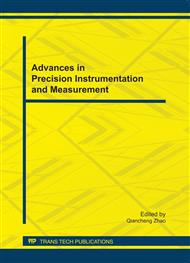p.578
p.583
p.587
p.592
p.600
p.606
p.611
p.616
p.622
Development of Position Detector with Large Sensing Area Using Frosted Glass
Abstract:
This paper proposes a new position detector using frosted glass and four photo detectors. Four photo detectors are arranged under the four corners of the rough surface of frosted glass. When this sensor is irradiated by laser pointer, the light repeats reflection in the frosted glass and arrives at the photo detectors. The light intensity decreases by the increasing of distance between the photo detector and the irradiating point. Therefore, the distance between a photo detector and the irradiation point can be worked out from the output of the photo detectors. Thus, the light irradiation point can be derived from the distances with the four photo detectors. This sensor is low cost and has a large sensing area. In addition, this sensor also can be used as a pointing device because the movement of the light on the frosted glass can be judged.
Info:
Periodical:
Pages:
600-605
Citation:
Online since:
September 2011
Price:
Сopyright:
© 2012 Trans Tech Publications Ltd. All Rights Reserved
Share:
Citation:


